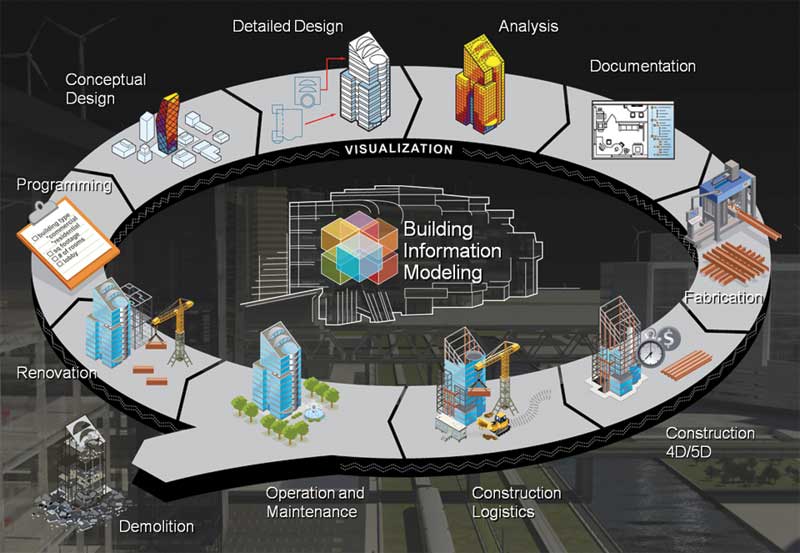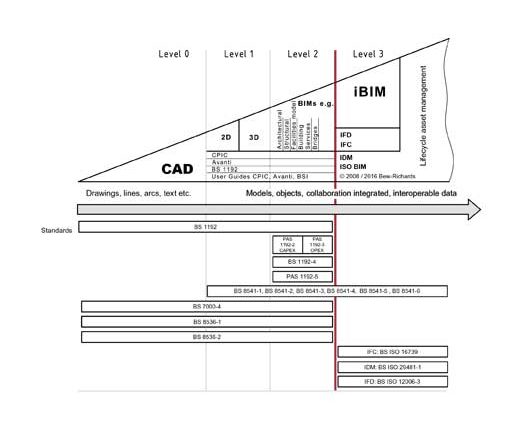BIM in Canada: Moving toward a national mandate for building information modelling
by Katie Daniel | December 6, 2016 10:49 am
 [1]
[1]By Erik Poirier, PhD, LEED AP
The Canadian architecture, engineering, construction, owner, and operator (AECOO) community is ripe for change. Building information modelling (BIM) provides a framework to prompt and guide this transformation. Many countries around the globe have put forth BIM mandates to support the collaborative process’ deployment—the goal is to improve the performance and value generated by their respective design, construction, and asset management sectors.
Canada’s public bodies are notably lagging behind in this regard. buildingSMART Canada has issued a call to action, in the form of its “Roadmap to Lifecycle BIM in the Canadian AECOO Community,” which sets the foundation and provides a way forward for governmental mandates at all levels in this country.
BIM is the process of collaboratively developing and managing an integrated digital model containing a built asset’s geometry and life cycle information. The model acts as a ‘single source of truth,’ and supports the many practices involved in the design, construction, operation, and management of a built asset.
The underlying principle of BIM is a data-driven approach to project delivery—as opposed to the traditional, 2D/representational approach that has been the norm in the past. While a single, unified model is still some ways off due to practical, technical, and organizational issues, there is increasing empirical evidence that BIM, deployed within an appropriate environment, can lead to important gains in efficiencies. These gains are attributable to high-quality, streamlined information flows that result in fewer errors and support global optimization of asset life cycle practices. This results in clear, quantifiable outcomes. For example, the U.K. Ministry of Justice has been implementing BIM on its projects since 2009; it recently reported[2] upward of 20 per cent reduction in construction costs on recent projects.
Why the need for a mandate?
The statistics speaking to the importance of the Canadian design, construction, and asset management sector are well-known. Construction alone (not including design or operations) represents seven per cent of the country’s gross domestic product (GDP) and seven per cent of employment. (See Industry Canada’s 2014 report, “Construction [NAICS 23] : Gross domestic product [GDP]” at www.ic.gc.ca/app/scr/sbms/sbb/cis/gdp.html?code=23&lang=eng[3].) Moreover, the sector is one of the country’s biggest generators of value, representing $290 billion in capital expenditures every year. (For more, see Statistics Canada’s 2013 report, “Capital Expenditures for Construction by Sector, By Province and Territory [Canada].” Visit www.statcan.gc.ca/tables-tableaux/sum-som/l01/cst01/busi01a-eng.htm[4].)
The sector possesses shortcomings, however, that are equally well known. For instance, poor project documentation has been shown to add 10 to 15 per cent to project costs. (This comes from Engineers Australia’s 2005 report, “Getting it Right the First Time: A Plan to Reverse Declining Standards in Project Design Documentation within the Building and Construction Industry,” by the Queensland Division Task Force on the quality of documentation.) A lack of interoperability within the industry represents $15.8 billion in losses per year in the United States (of which owners bear two-thirds), due in part to incompatibilities between information sources and formats throughout an asset’s information life cycle. (Michael P. Gallaher et al’s 2004 report, “Cost Analysis of Inadequate Interoperability in the U.S. Capital Facilities Industry” is National Institute of Standards and Technology [NIST] Publication GCR 04-867. It can be read by visiting www.bfrl.nist.gov/oae/publications/gcrs/04867.pdf[5].) These are but two telling examples of the considerable amounts of waste generated throughout an asset’s life cycle. In the end, the potential of this key economic sector remains largely untapped. In other words, Canada is not getting the full value for its money.
Government bodies across the country—federal, provincial/territorial, or municipal—face critical needs for infrastructure, find their public budgets under increasing pressure, and need to bring environmental considerations front and centre. Within this context, the current business model in which the AECOO community operates is
no longer viable—stimulating innovation has become paramount.

Photo © BigstockPhoto
Governments around the globe have recognized this and put in place initiatives actively supporting the transformation of their respective industries. The motivation of these government bodies comes from an understanding of the importance of the AECOO community to a country’s vitality and economic competitiveness on a global scale. For instance, the United Kingdom’s Construction Strategy sets four key target areas for improvement:
- 33 per cent lower costs for construction and whole life costs of built assets;
- 50 per cent faster delivery of projects;
- 50 per cent reduction in greenhouse (GHG) gas emissions; and
- 50 per cent improvement in exports of construction services, materials, and products. (The HM Government’s Department for Business, Innovation, and Skills 2013 report, “Construction 2025: Industrial Strategy−Government and Industry in Partnership,” is available at
www.gov.uk/government/publications/construction-2025-strategy[6].)
The Singaporean government developed a strategic plan to transition to a knowledge-based economy in 1999. Its design, construction, and asset management sectors were deemed central to this transformation, as highlighted in the report, “Construction 21: Reinventing Construction,” which sought to transition from “dirty, demanding, and dangerous (3D)” sectors to “professional, productive, and progressive (3P)” ones.
In both cases, these strategies were partially supported through the mandating of BIM-based project delivery. Other countries have also moved or are in the process of moving toward BIM, such as Finland, Denmark, Norway, France, Germany, and, most recently, Russia. In the United States, the General Services Administration (GSA) and the Department of Defense’s MILCON, as well as many states, cities, and large universities, have been adopting BIM since the mid-2000s. In fact, when looking at Canada’s G7 partners, every country except our own has some form of national strategy for the transformation of its design, construction, and asset management sectors, supported through BIM-enabled project delivery.
Consequences in Canada
The consequences of not having a clear strategy for the transformation of the Canadian AECOO community, enacted through a strong mandate for BIM-enabled project delivery, are multi-facetted:
1. The status quo comes at a cost. As mentioned, there is tremendous opportunity to generate value for Canada that is being squandered due to inefficient practices. This represents billions of dollars of wasted potential every year.
2. Both limited consideration of sustainability during design and poor use of resources during construction impacts our environment. This is particularly important in light of Canada’s commitment to reducing its GHG emissions in line with the Conference of the Parties (COP) 21 Paris Agreement.
3. Canada risks losing its position in terms of innovation and competitiveness on a national and international scale in one of its most important industry sectors. While other countries are investing in their AECOO community to support research and development and promote innovation and best practices, Canada shows very limited support for this sector. Granted, initiatives exist and research funds are available, but they are generally fragmented, localized, and yield results that benefit only those directly involved.
The risks of not having a clear mandate to support the deployment of BIM across Canada are multiple. Primarily, there is the risk of a growing disparity within the AECOO community between BIM adopters and non-adopters. This disparity will only exacerbate an already-fragmented industry.
What we are seeing right now is advance of implementation, but only in some companies—predominately large firms with the resources and capabilities to undertake the transition alone, or smaller firms that have sensed the tremendous opportunity and can get direct benefits from implementation (e.g. mechanical subcontractors who can prefabricate from the model). On the other hand, many small or medium-sized firms, which may not see a direct benefit from BIM (e.g. electrical engineers who move from a one-dimensional/schematic workspace to a three-dimensional one) are falling behind. This also applies to firms lacking awareness or not knowing how to undertake
this transition.
When one considers that 60.8 per cent of the Canadian construction industry is made up of micro-enterprises[7] (i.e. less than five employees), the gap has the potential to grow to a point where it becomes unsurmountable. Moreover, the disparity is not only within the supply chain, but also across asset life cycles.
Right now, the bulk of BIM use in Canada is focused on construction (i.e. clash detection, co-ordination, visual checking, and some planning and scheduling), with limited use during the design phase. (Use of 3D modelling in the design phase is widespread, but applying ‘true BIM’—analysis, automation, computation/parameterization, validation, and optimization—is less so.) This results in asymmetrical benefits accruing to one or two stakeholders in the supply chain, usually the general contractor. Unfortunately, this reinforces the piecemeal implementation of BIM—that is, optimizing BIM for specific uses and not with the asset’s information life cycle in mind. BIM implementation is also still largely oriented toward buildings. This means there exists tremendous opportunity for its application for linear infrastructure.
In this light, there is a serious risk of BIM use ‘stagnating.’ In other words, once the low-hanging fruit have been reaped, the AECOO community can become complacent and not push to explore new avenues and develop new capabilities. For instance, mainstream use of BIM for facilities management is extremely limited, and has largely been deployed in the context of pilot and research projects—despite the fact it is often touted as having the most potential to generate value. (This comes from Mcgraw-Hill’s “Smart Market Report 2014: the Business Value of BIM for Owners.” Visit i2sl.org/elibrary/documents/Business_Value_of_BIM_for_Owners_SMR_(2014).pdf[8].)
 [9]
[9]Image courtesy Autodesk
Finally, without a strong mandate, BIM deployment in Canada risks being left to individual companies that develop their own standards and mechanisms; this could result in an ad-hoc, disparate, and fragmented implementation process. The country could end up with various forms of standards and guidelines, hindering the overall implementation process—effort will be wasted on attempting to bridge these different standards and guidelines and fulfil these different mandates, instead of focusing on value-adding activities.
To overcome the current limitations of BIM use in Canada, mitigate the risks associated to an ad-hoc implementation, and, most importantly, provide the Canadian AECOO community with a clear direction for its transition toward a highly efficient and value-generating one, a strong BIM mandate is key. Further, it must happen at the national, provincial/territorial, and municipal levels.
What does a mandate entail?
Existing or emerging mandates from around the world vary widely in scope and intent. They all have at their core, however, requirements relating to BIM and expected outcomes relating to its use on publicly funded projects. The key element is a mandate should be specifying ‘outcomes,’ rather than ‘means and methods.’ This is important since clients typically do not tell their supply chain how to deliver their projects (nor do they want to).
More precisely, a national mandate should be developed that:
- coherently scopes its extent and reach;
- clearly describes the relevant requirements, outcomes,
and deliverables; - references international standards (e.g. ISO 16739:2013, Industry Foundation Classes [IFC] for Data-sharing in
the Construction and Facility Management Industries, or
ISO 29481, Building Information Models: Information Delivery Manual); - references national standards and guidelines (a ‘Canadian National BIM Standard’ would have to be developed, akin to the one in the United States);
- would be scalable in that it would define minimum requirements for various types of projects or levels of implementation required; and
- would be evolutive in that it would take into account current capabilities within the industry and evolve through time as the industry grows more mature (similarly to the United Kingdom’s BIM levels).
For example, a first, basic mandate would call for the provision of a co-ordinated (i.e. zero true-positive clashes to within a certain tolerance), multi-disciplinary, federated model that will contain basic asset information (i.e. model elements developed to specific Levels of Development [LOD]) at tender, and is kept current during construction with manufacturer information, including warranty, for major asset types upon completion of the project. Throughout project delivery, data drops would be specified (to replace the traditional 30, 60, and 90 per cent revision milestones), and clear sets of minimum expected data would be defined at each stage. (Data drops in the context of U.K. projects are discussed at www.bimtaskgroup.org/cobie-data-drops[10].) The federated model would be delivered using open standards for BIM, namely industry foundation classes (IFCs) and the model view definition (MVD) framework, satisfying the developed national BIM standard. This would become the minimum requirement for all publicly funded projects in Canada (should the mandate be adopted at all tiers of government across the country).
It is important to note this mandate would not dictate how project teams develop or use models throughout a project’s life cycle. Instead, it would establish a common baseline for models in the public realm, which could be automatically audited and validated. One could think of this as the performance-based National Building Code of Canada (NBC) for the project delivery process.
It is also critical to note the national BIM mandate is part of a larger framework supporting the Canadian AECOO community’s transition to more efficient and effective practices, as well as the generation of best value for money on public projects. This framework comprises:
- a national strategy for the Canadian AECOO community that lays out the need for change and establishes the way forward, with BIM as part of the solution (this strategy should be developed and endorsed by all levels of government and public
bodies such as universities and healthcare facilities); - a national BIM mandate that sets the foundation for BIM use across Canada as part of a nation-wide strategy for the Canadian design, construction, and asset management sector; and
- a national BIM standard and guidelines that provides the direction and support for the delivery of BIM in the context of publicly funded projects.
 [11]
[11]Image courtesy BSI
What are the challenges and risks associated with this strategy and mandate?
The biggest challenge to this strategy is the current capability and awareness gap associated with BIM in Canada. While the mandate aims to close that gap, the strategy will have to lay out a clear plan and provide significant resources to support training and education programs across Canada to help all AECOO stakeholders get up to speed. Another risk is the asymmetrical or inconsistent mandating of BIM by different public bodies across Canada. This is why a national strategy, mandate, and BIM standard are highlighted as being necessary to ensure consistency of the implementation process. Should local or provincial governments start developing mandates and standards in isolation, there is a great risk of causing confusion and undue complexity throughout the project delivery process. Further, inconsistent BIM mandates across the country would exacerbate the capabilities gap.
How do we get there?
In January 2015, buildingSMART Canada published its “Roadmap to Life Cycle BIM in the Canadian AECOO Community.”[13] Issued as a call to action, it lays out a comprehensive plan to guide the Canadian AECOO community in improving its performance and contributing more effectively the country’s societal, environmental, and economic development.
The ‘roadmap’ is founded on six principles:
- All Canadian AECOO community stakeholders, at all levels, must be actively engaged in the sector’s transformation.
- The technologies, processes, and standards supporting the transformation must be developed and maintained in a rigorous, consistent, and continual way.
- All Canadian AECOO community stakeholders must be educated and trained to ensure the transformation be successful and maintained.
- The tools, technology, and processes that are developed must be deployed and adopted within a conducive environment across the Canadian AECOO community.
- The progression of this transformation must be continuously monitored and evaluated for ensuring effectiveness.
- The movement must be sustained by all Canadian AECOO community stakeholders well beyond the initial transformation cycle.
These six principles form the basis for the six streams of the roadmap, which are seen as key in advancing and framing the BIM agenda forward
in Canada.
Over the past two years, buildingSMART Canada has been actively working toward fulfilling the roadmap activities and has garnered considerable support from industry stakeholders. However, it is still some ways off from a comprehensive and conducive environment for the deployment of BIM in Canada. It is time for public bodies to heed this call to action and take the appropriate steps toward a more efficient and effective AECOO community through better project delivery practices enabled through BIM and open standards.
 Erik Poirier, PhD, M.Eng., B.Sc.Arch., LEED AP, chairs the Communications Committee of buildingSMART Canada. He is a postdoctoral fellow at the University of British Columbia’s (UBC’s) building information modelling (BIM) TOPiCS Lab and senior partner at Alta Brevis Partnership. Poirier’s work focuses on enabling collaboration in the AECOO sector through BIM, lean, and integrated approaches. He also specializes in optimizing information life cycles for the built environment. Poirier has co-authored more than a dozen publications in refereed journals and conferences, and has participated in the production of many industry reports and conferences. He can be reached by e-mail at epoirier@ibc-bsc.ca[14].
Erik Poirier, PhD, M.Eng., B.Sc.Arch., LEED AP, chairs the Communications Committee of buildingSMART Canada. He is a postdoctoral fellow at the University of British Columbia’s (UBC’s) building information modelling (BIM) TOPiCS Lab and senior partner at Alta Brevis Partnership. Poirier’s work focuses on enabling collaboration in the AECOO sector through BIM, lean, and integrated approaches. He also specializes in optimizing information life cycles for the built environment. Poirier has co-authored more than a dozen publications in refereed journals and conferences, and has participated in the production of many industry reports and conferences. He can be reached by e-mail at epoirier@ibc-bsc.ca[14].
- [Image]: https://www.constructioncanada.net/wp-content/uploads/2016/12/dreamstime_l_30276950.jpg
- reported: http://bim-level2.org/globalassets/pdfs/uk-guide-chapter-1-introduction.pdf
- www.ic.gc.ca/app/scr/sbms/sbb/cis/gdp.html?code=23&lang=eng: http://www.ic.gc.ca/app/scr/sbms/sbb/cis/gdp.html?code=23&lang=eng
- www.statcan.gc.ca/tables-tableaux/sum-som/l01/cst01/busi01a-eng.htm: http://www.statcan.gc.ca/tables-tableaux/sum-som/l01/cst01/busi01a-eng.htm
- www.bfrl.nist.gov/oae/publications/gcrs/04867.pdf: http://www.bfrl.nist.gov/oae/publications/gcrs/04867.pdf
- www.gov.uk/government/publications/construction-2025-strategy: http://www.gov.uk/government/publications/construction-2025-strategy
- micro-enterprises: http://www.ic.gc.ca/app/scr/sbms/sbb/cis/establishments.html?code=23&lang=eng
- i2sl.org/elibrary/documents/Business_Value_of_BIM_for_Owners_SMR_(2014).pdf: http://i2sl.org/elibrary/documents/Business_Value_of_BIM_for_Owners_SMR_(2014).pdf
- [Image]: https://www.constructioncanada.net/wp-content/uploads/2016/12/BIM_Illustration.jpg
- www.bimtaskgroup.org/cobie-data-drops: http://www.bimtaskgroup.org/cobie-data-drops
- [Image]: https://www.constructioncanada.net/wp-content/uploads/2016/12/NA_Maturity-model-BIM_03-e1480706027351.jpg
- www.bsigroup.com/Shop: http://www.bsigroup.com/Shop
- “Roadmap to Life Cycle BIM in the Canadian AECOO Community.”: http://www.buildingsmartcanada.ca/roadmap-to-lifecycle-bim
- epoirier@ibc-bsc.ca: http://epoirier@ibc-bsc.ca
Source URL: https://www.constructioncanada.net/bim-in-canada-moving-toward-a-national-mandate-for-building-information-modelling/